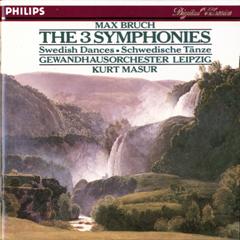Max Bruch - The 3 Symphonies-Swedish Dances (2008)
Max Bruch - The 3 Symphonies-Swedish Dances (2008)

Disc 1 1 Symphony No. 1: 1. Allegro maestoso 10:19 2 Symphony No. 1: 2. Scherzo 5:17 3 Symphony No. 1: 3. Quasi fantasia 5:15 4 Symphony No. 1: 4. Finale 7:53 5 Symphony No. 3: 1. Andante sostenuto 10:54 6 Symphony No. 3: 2. Adagio 8:37 7 Symphony No. 3: 3. Scherzo 6:19 8 Symphony No. 3: 4. Finale 6:00 Disc 2 1 Symphony No. 2: 1. Allegro passionato 12:03 2 Symphony No. 2: 2. Adagio ma non troppo 11:09 3 Symphony No. 2: 3. Allegro molto tranquillo 10:59 4 Swedish Dances: 1. Einleitung, Sehr massig 1:58 5 Swedish Dances: 2. Ruhig bewegt 1:14 6 Swedish Dances: 3. Frisch, mit Energie 1:10 7 Swedish Dances: 4. Langsam, nicht schleppend 1:21 8 Swedish Dances: 5. Ziemlich schnell 1:06 9 Swedish Dances: 6. Langsam, nicht schleppend 2:09 10 Swedish Dances: 7. Lebhaft 1:00 Gewandhausorchester Leipzig Kurt Masur – conductor
Max Bruch's three symphonies are not neglected masterpieces that need only competent performance, to reveal their stature. They are works whose rather reticent melodic style, at times dense scoring and formal stiffness, need affectionate help if their genuine qualities are to emerge and outweigh their flaws. Carefully handled there is real romantic charm (and some agreeably brusque sturdiness) to the first movement of the Third Symphony; its Adagio has sonorous solemnity and an ardent climax, and its Scherzo some fire. The Second Symphony, its over-extended finale apart, is stronger still, but both are apt at times to sound crabbed, at others uncomfortably dense. On the whole I wasn't wholly convinced by Kurt Masur's advocacy on his Philips set. The sheer splendour of the Gewandhaus orchestra's sound, which ought to show Bruch in the best light, in fact rather weighs him down, especially when combined with a recording that pays special attention to the richness of the orchestra's bass register. Bruch's palette is quite dark enough as it is, with his fondness for instruments in the middle range and for rather close-set counterpoint.
Conlon and his Cologne players cannot always disguise passages of awkwardly coarse scoring, but their sound, though full, is leaner and less bass-dominated than that of the Gewandhaus, and that is in itself an advantage. Conlon is also more likely to relax into Bruch's genial melodies, to linger and shape them with affectionate rubato. For some tastes Masur's urgency will compensate for his at times lumbering massiveness of sound: playing the slow movement of the Third Symphony about 20 per cent faster than Conlon he certainly gives the music intensity of expression, but I found the leisured, warm phrasing of Conlon's account far more endearing. Masur is often faster than Conlon (his set includes a set of six Swedish Dances but adds only two minutes to Conlon's overall timing), but although longueurs are obvious in both conductors' hands, Conlon seems the more concerned to persuade us not to mind them. Even he is a bit heavy-footed at times (in the Scherzo of the Third Symphony, for example) but for anyone wanting all the symphonies of this neglected but likeable composer his set is a pretty safe recommendation.
Neither set is especially good value, though. Since the Second and Third Symphonies could easily be accommodated on a single CD, it's a pity that you're obliged in both cases to acquire the much less distinguished First as well, for a substantial extra outlay. I can't help pointing out that the Third Symphony is available in a reading less sumptuous but more winning and more relaxed than either Conlon or Masur, by Manfred Honeck and the Hungarian State Orchestra.' --- Michael Oliver, gramophone.co.uk
download (mp3 @320 kbs):
yandex 4shared mega cloudmailru uplea ge.tt
